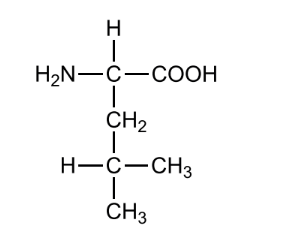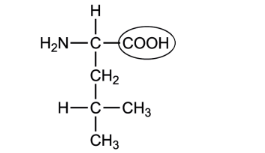Question
(a) Outline the structure of proteins. [3]
(b) Cells produce a large variety of proteins with different sequences of amino acids. Explain how this is done. [7]
(c) Outline the range of functions of proteins in cells. [5]
▶️Answer/Explanation
Ans:
a
a. protein formed from amino acids OR 20 different amino acids
b. linked together by peptide bonds
c. may consist of one or more polypeptides linked together
d. have a specific shape/conformation/folding
e. shape determines function Outline
b
a. protein is produced when a gene is expressed / switched on
b. genetic code/codons consists of three nucleotides/bases/base triplet
c. genetic code in DNA is transcribed/transcription (to mRNA)
d. mRNA exits the nucleus
e. mRNA (code) is translated/translation into a polypeptide/protein
f. amino acid sequence/polypeptide formation occurs at a ribosome
g. one codon translates to one amino acid
h. tRNA carries code for specific amino acids
i. tRNA anticodon matches with specific codon in mRNA
j. amino acids joined (by peptide bonds) to form polypeptide
k. sequence of amino acids determined by order of bases/nucleotides/codons in DNA/mRNA
l. proteins vary based on which amino acids are used and their order OR protein variety increases by mutations to DNA Explain
c
a. enzymes that catalyse/speed up/control (the rate and direction of) metabolic reactions
b. proteins can be hormones which are chemical messengers to cells
c. proteins that transport through the membrane such as channel/carrier/pumps / that regulate what enters/leaves the cell
d. hemoglobin in red blood cells that transports/ binds oxygen
e. membrane proteins for cell/tissue recognition/cell adhesion/communication
f. structural elements of muscle fibre/actin/myosin for movement OR spindle fibres move chromosomes
g. histones condense DNA into chromosomes Outline The question requires answer that the function is in cells
Question
The diagram shows the molecular structure of the amino acid leucine.

(a) Draw a circle on the diagram to enclose the carboxyl group. [1]
(b) State one protein that acts as a hormone. [1]
(c) Explain how enzymes are used in the preparation of milk suitable for individuals who are lactose intolerant. [2]
▶️Answer/Explanation
a

b insulin/glucagon/ADH/oxytocin/leptin / other verified example;
c a. the enzyme lactase acts on lactose;
b. the enzymes are immobilised / are bound to alginate beads;
c. (pouring milk over the immobilised enzymes) causes lactose to be hydrolysed/broken down into monosaccharides/glucose and galactose;
